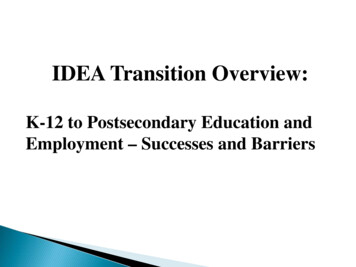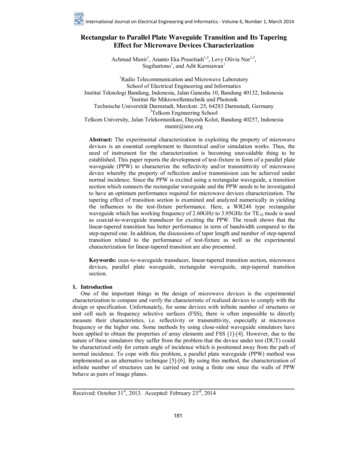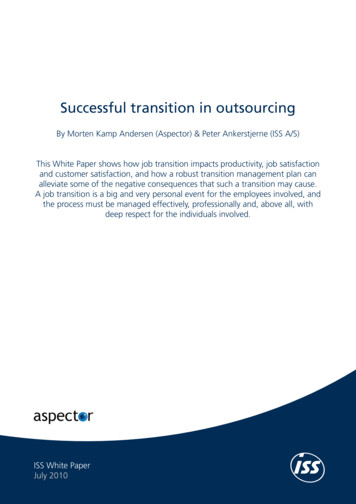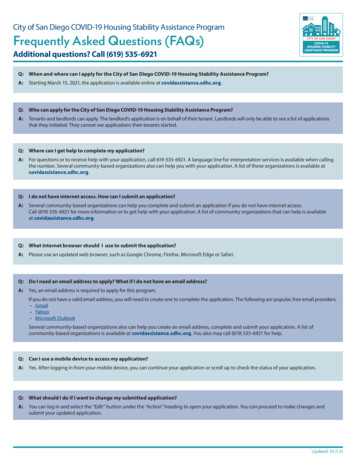
Transcription
Rapid Rehousing Transition Plans:Guidance for Local Authorities andPartnersDeveloping a RapidRehousing Transition Plan2022 to 2027October 2021Mae’r ddogfen yma hefyd ar gael yn Gymraeg.This document is also available in Welsh. Crown copyright 2021WG43581Digital ISBN 978-1-80391-016-1
DefinitionsInterventions:Housing First – an internationally recognised approach which is targeted at thoseindividuals with high levels of needs into setlled accommodation, alongside tailoredand individualised support package, at the earliest opportunity. In Wales, theHousing First Network developed a set of ten principles based on the internationalprinciples. H1st Principles Wales - ENG A5.pdf (cymorthcymru.org.uk)Critical Time Interventions (CTI) - A time-limited approach, providing an intensivelevel of support for a short duration, which decreases significantly over time.Potentially most suitable for people leaving state institutions such as hospital orprison, etc.Floating support - housing related support provided to a person in their own home orin a dispersed accommodation (as opposed to fixed accommodation based serviceswhere support is provided through the accommodation).Assertive Outreach – persistent support offered on the street to ensure peoplesleeping rough transition into the support available and with the ultimate goal ofending homelessness.Accommodation Types:Temporary Accommodation – term to include all accommodation that is providedupon first presentation to homelessness services, which may or may not under alicense agreement, and which is not intended to be longer-term provision. Floorspace is not considered suitable under any circumstances.Triage Centre – enhanced forms of temporary accommodation where people aresupported on a short-term basis while an assessment is undertaken in relation to theappropriate accommodation and support requirements.Triage Centres remain a key objective and the key principles are that a successfulTriage Centre must be: Single person/household occupancy accommodation - As a minimum, theaccommodation should have en-suite, but ideally also include a smallkitchen area with sink and microwave. Post-pandemic, shared communalspaces will also be encouraged where appropriate;Inclusive - Ensure provision covers all groups (i.e. men and women, youngpeople, those with pets, etc.). This may include different buildings,entrances or different floors for different cohorts;Open 24 hours a day, 7 days a week - Staff cover allows for emergencyaccommodation to be available at all times of day, every day;Hub approach - Centre allows for a multi-agency approach and co-locationwith key services such as primary health services and substance misuseservices.2
Settled Accommodation – accommodation in both the social and private sectors thatis expected to last at least six months and has the potential to be available for aslong as the tenant wishes.Supported Accommodation for homeless people – the provision of accommodationalongside support to help people live as independently as possible, but is notintended to be settled accommodation.Repeat Homelessness – an individual/household who has at least one previousexperience of homelessness, regardless of whether (a) a duty was owed undereither the Housing Act 1996 or the Housing (Wales) Act 2014; or (b) the case wassuccessfully prevented and temporary accommodation was avoided. There is notime limit on the previous instance of homelessness.Local Housing Market Assessment (LHMA) – a strategic planning exerciseundertaken every five years (plus a refresh once during that period around years 23) to determine housing need, by ward and by rental type (i.e., social, intermediate,market, etc.).Local Authority Prospectus – drawn from LHMA, a concise summary of housingneed which identifies an authority’s housing priorities for the Social Housing Grant.Local Development Plan - sets out each local planning authority's proposals forfuture development and use of land in their area.Prevention:Primary Prevention - Preventing or minimising the risk of problems arising, usuallythrough universal policies e.g. education; health promotion; good housingmanagement and tenancy support.Secondary Prevention - Targeting individuals or groups at high risk or showing earlysigns of a particular problem to try to stop it occurring e.g. early referral to family oryouth support services.Tertiary Prevention- Intervening once there is a problem to stop it getting worse andto redress the situation e.g. writing off rent arrears to avoid eviction.Acute Spending - Spending to manage the impact of a crisis situation - does little ornothing to prevent problems recurring in future e.g. cost of temporary housing whenmade homeless; long term cost of supporting children who have suffered AdverseChildhood Experiences (ACEs) as a result of loss of home. Followingtransformation, it is expected that this prevention category will reduce independency.Recovery Prevention – prevention of repeat homelessness and rough sleeping.3
Contents Page1. Welsh Government’s Vision2. What is Rapid Rehousing?3. Aligning Local Need4. Partnership Working5. Rapid Rehousing Transition PlansA.B.C.D.E.F.Homelessness Data and analysing needAssessing Support NeedsUnderstanding local Temporary AccommodationPlanning for Temporary Accommodation transitionDevelopment of the PlanResource PlanningAnnex1. Rapid Rehousing Transition Plan Template2. Transition tool (excel spreadsheet)4
1.Welsh Government’s visionThe Welsh government is committed to making homelessness rare, brief andunrepeated. This does not mean that all of our focus will be on the emergency endof homelessness. Prevention of homelessness must remain our primary focus. Wewant to see action at both Primary and Secondary Prevention stages (see definitionsabove) in order to achieve a higher rate of success in relation to keeping people intheir own homes.Where prevention has not worked, Rapid Rehousing is then essential to reduce thecorrosive impact of homelessness and ensure it is unrepeated. The benefits ofsecure, settled and self-contained housing for people who have experienced or beenat risk of homelessness should not be underestimated. The majority of peopleexperiencing homelessness should be provided with such homes as quickly aspossible. This will help avoid the destabilising and marginalising effects of prolongedhomelessness or prolonged stays in emergency or temporary settings whileremaining homeless.Rapid rehousing is based upon a systematic approach to understanding whathousing is needed, how that housing is going to be funded, developed and allocatedto people who find themselves homeless. This approach, when properly applied,means the need for many forms of temporary accommodation will diminish andwhere it is needed, is for a shorter period than currently.We know there is a shortage of housing in many parts of Wales, we also know thatirrespective of your location, a person or family’s ability to access housing isdependent on a supply of appropriate housing and the way it is allocated.Particularly, the criteria a landlord uses to match homeless households to tenancies.Rapid Rehousing will help us reduce the use of temporary accommodation to theabsolute minimum and improve access to settled housing as rapidly as possible.PartnershipsWhile Rapid Rehousing clearly places an emphasis on the provision of housing as afundamental element of recovery from homeless, homelessness cannot be resolvedwith just housing alone. For Rapid Rehousing to work, we must work in partnershipwith key services such as health and criminal justice. We must also harness boththe third sector and unpaid volunteers who provide services that support and helptenants build confidence and a connection within a community. Partnershipapproaches will be vital, not just in making the transition to Rapid Rehousing, butalso to support the planning that is required to prepare a transition plan. It isessential that every authority establishes a steering group of key services and localpartners, both internally and externally, when developing the transition plan.Support, Plan, Build and TransformThe four key themes of the Phase 2 plan remain in place, but now with an eye on theneed to make the transition to Rapid Rehousing:5
Support– continue to appropriately support people who remain rough sleeping, arein temporary accommodation and those recently moved into settled accommodation.Plan – prepare clear transition plans for services and provision setting out how theywill move towards providing more sustainable models of accommodation andsupport that meets the needs of everyone currently in emergency provision andfuture presentations.Build – innovate, remodel, procure and build accommodation to improve the qualityand inclusivity of temporary accommodation and increase the availability of settledaccommodation.Transform – commit to a transition plan focused on moving away from the use oftemporary accommodation, to a system of assessing needs quickly and identifyingthe most appropriate route that meet the needs and the wishes of individuals. Theplan must also consider how rough sleeper services are remodelled to incentiviseand support people to make the step into services.TimetableThe publication of this guidance represents the starting point on the transition toRapid Rehousing.1. October 2021 – publication of Rapid Rehousing Transition Plan Guidance2. October 2021 – consultation on the Ending Homelessness Action Plan3. December 2021 – initial submission of draft Housing Support ProgrammeStrategy (including needs assessment exercise)4. End of March 2022 – begin work to explore legislative changes5. End of March 2022 – submission of final Housing Support ProgrammeStrategy6. End of June 2022 – initial submission of draft Rapid Rehousing TransitionPlan; and7. End of September 2022 – final submission of Rapid Rehousing TransitionPlan.6
2. What is Rapid Rehousing?Rapid Rehousing is about taking a housing led approach to rehousing people thatare experiencing homelessness, making sure they reach settled housing as quicklyas possible rather than staying in temporary accommodation for too long.Over the next five years we expect to see removal of prolonged and potentiallydamaging spells in temporary accommodation. We expect to see the development ofa systematic and strategic process that links housing development, support andsupply to housing need. Doing so will enable allocation processes and PRS accesspoints that focus on getting households experiencing homelessness into appropriatesettled homes and target support to meet their needs.Prevention remains the most efficient way of tackling homelessness and mustremain a key priority, but where homelessness cannot be prevented, we want: Systematic planning to make settled accommodation available. Move into settled accommodation at the same time as, rather than after,addressing support needs. An improvement in the quality and a reduction in the need for temporaryaccommodation. Offering a package of assistance and multi-agency support, specially tailoredto individual needs where this is required.Rapid Rehousing should be flexible and recognise that people who present ashomeless may have different levels of need. It is about acknowledging that withoutaccess to adequate housing, individuals may experience multiple adverse effectsincluding: exposure to disease, poverty, isolation, mental health issues, prejudiceand discrimination, and are under constant and significant threat to their personalsafety.Rapid Rehousing Model of AccommodationRapid Rehousing is based on the principles of moving people to settledaccommodation quickly, with temporary accommodation although key, ideally beinga limited part of the model.Many local authorities currently utilise a pathway for people experiencinghomelessness which may include a number of different stages of ‘tenancyreadiness’. As part of the transformation, local authorities must begin planning tomove to model with no more than two stages (1) Temporary accommodation, and (2)Settled accommodation and ideally just settled accommodation if support can beprovided early enough.7
Within these two stages, there remains flexibility based on the needs of theindividual. For example:Stage one - Temporary AccommodationThis includes the provision of both Triage Centres, to assess the needs of individualsand good quality, inclusive temporary accommodation. It is our intention to phaseout the use of poorer quality temporary accommodation in all instances during thetransition phase, including the use of B&Bs. However, we recognise this will takesome time given the current increased demand on provision.There is no intention to place a time limit on this stage, but the emphasis is on,where it is necessary, a short as possible stay to undertake an assessment prior to amove into settled accommodation. The length of stay will depend on the outcomesof the assessment and individual choices.Stage one includes all fixed site Housing Support Grant (HSG) funded provision, allSupported Accommodation, Domestic Abuse Refuges, Residential RehabilitationCentres, etc.In very few instances, some may require Supported Accommodation on a long-termbasis, but this should be kept under continual review and is not to be consideredSettled Accommodation.Stage two – Settled AccommodationThe discharge conditions attached to the duties within the Housing (Wales) Act 2014reinforce six months as an appropriate threshold for settled accommodation. Thisexcludes supported accommodation or interim tenancies that carry no opportunity tobe converted into longer term tenancies.8
The Renting Homes (Wales) Act 2016 will put in place two contracts - ‘secure’ and‘standard’ - and the expectation is that Stage two would include the provision of oneof the two contract options. This would include the provision of an introductorystandard contract (a type of ‘standard contract’). Similarly to current introductory andstarter tenancies, an introductory standard contract will usually become a securecontract after the introductory period. However, under no circumstances should thetransition to a secure contract be conditional on behaviour or participation during theintroductory period.Settled accommodation may also be provided in a shared setting, particularly foryounger people. However, this does not mean that the default position for anygroups should be shared. Decisions should be made on a case by case basis and ofcourse take account of the individual’s preferences.What is the relationship between Rapid Rehousing and Housing First?Housing First is considered the most highly regarded form of Rapid Rehousinginternationally and such, should fit within the wider Rapid Rehousing approach,targeted at those with high needs, and also those with lower level needs but a historyof failed tenancies and/or repeated experiences of rough sleeping.As part of the transition to the RapidRehousing approach, we ask alllocal authorities to invest in aHousing First service in order tosupport the needs of those identifiedas high needs. However, we are notopposed to alternative housing-ledmodels that allow for a speediermove out of temporaryaccommodation and into settledaccommodation. This may includethe provision of an alternativetemporary solution if it is moreappropriate to the individual’s needs (i.e., wet, dry, young person provision, etc.).Personal choice is of paramount importance in both Housing First and RapidRehousing and if someone expresses a desire to be placed in a shared setting, be ita shared tenancy, HMO or even a supported project, then that should be consideredand potentially supported.9
3. Aligning Housing to local needA pre-requisite of Rapid Rehousing is ensuring there are planning arrangements toensure: (a) enough secure, affordable accommodation available; and (b) enough ofthe right support available to assist people to secure and sustain settledaccommodation. It is fundamentally important that transition plans are built onreliable and comprehensive data.This places a significant emphasis on the understanding of the needs assessmentexercise as well as the accompanying Rapid Rehousing Transition Plan Excel toolwhich has been developed in order to support the understanding of both currentdemand and potential trend information.Core data is essential and should be collected in:1. The local authority Local Housing Market Assessment (LHMA), Local Authorityprospectus (Social Housing Grant (SHG) Programme) and Local DevelopmentPlans,2. The Housing Support Programme Strategy and,3. The Rapid Rehousing Transition Plan.Capital Build Programmes:In order for Rapid Rehousing to work there must be appropriate access to housingand therefore it is of critical importance that each local authority ensures that there isconsistency between homelessness data and ongoing capital build programmes aswell as each authorities PRS access teams.As part of the Housing Support Programme Strategy process, each local authoritywill be expected to undertake regular needs assessment exercises and this exercisewill also be crucial in supporting the processing of planning the transition to Rapid10
Rehousing both in terms of this baseline exercise, but also in relation to ongoingmonitoring of the plan.Each local authority is strongly advised to ensure that there is alignment between thedata captured as part of the ongoing needs assessment and the development of theLocal Housing Market Assessment, Social Housing Grant Prospectus and LocalDevelopment Plan.In particular, we strongly recommend that the ‘existing unmet need’ householdscontained within the Local Housing Market Assessment table is linked directly to thehomelessness data collected by local authorities.11
4. Partnership workingHomelessness is not simply a housing issue and Rapid Rehousing will not succeedunless there is full operational alignment between an authorities housing strategicfunction, capital build programme, Housing Support Grant commissioning and thestatutory homelessness services. For any homelessness service to be effective,many homeless people will require support from a range of different partnersincluding primary care, mental health, substance misuse and social care services.In addition, for Rapid Rehousing to work, there must also be effective engagementfrom both within the local authority in terms of commissioning of support services,including HSG, and the planning of capital build programmes; should be supportedoutside the local authority interms of engagement withthe social and privatelandlord sectors and supportagencies.Local Rapid RehousingPartnership GroupsLocal authorities should lookto develop positive andcollaborative working andplanning relationships withkey partners such as health, social care, housing providers and the criminal justicesector in order to develop, resource and implement a fit-for-purpose plan. Thesearrangements should include a shared understanding of referral pathways and ashared understanding of service eligibility criteria.The Rapid Rehousing Transition Plan should describe how these partnership groupshave worked together to develop the Plan and also outline where these partnershipshave resulted in contributions of or demands on resources.Third sector homelessness and housing support providers will be critical partnersduring the transition to rapid rehousing. Their ability to build trusting relationshipswith people who have previously received a negative experience, perhaps evenbeen failed by the system, will be vital to service delivery, and their experience andexpertise should be utilised when making decisions about adapting services.In addition to the key local partners, partnership groups should include front lineworkers as well as people with a lived experience.Support commissioningChapter 7 of the Housing Support Grant Guidance (published April 2020)1 providesthe detail in relation to Housing Support Grant commissioning practices that will needto be followed.1Housing Support Grant Guidance (gov.wales)12
Rapid Rehousing Transition PlansA Rapid Rehousing Transition Plan is a planning document intended to support localauthorities make the transition to a Rapid Rehousing model of homelessnessservices.Its main purpose is to provide a plan of how each local authority will amend bothsupply and support requirements in order to align with the Rapid Rehousingapproach.We understand that some areas will require less change than others, but each planmust provide a detailed and costed analysis over a five year period.It is critical that this initial Transition Plan is developed as a corporate document. Inaddition to ensuring that the other authority statutory functions, such as social careare involved, there must be co-operation between the strategy team, SHG and HSGteams and homelessness services in order to deliver a plan that meet the aims of theRapid Rehousing transformation. Therefore, we expect to see Rapid Rehousingincorporated in local authorities’ Housing Support Programme Strategies which aredue to be submitted by the end of March 2022. Each local authority also needs todevelop and deliver the Rapid Rehousing Transition Plan in co-operation with localpartners, in particular Area Planning Boards, Registered Social Landlords, HSGsupport providers and wider relevant local partners.Each plan will need to set out the following six key themes:A.B.C.D.E.F.Homelessness data and analysing needAssessment of support needsUnderstanding local temporary accommodation supplyPlan for the Temporary Accommodation transformationDevelopment of the Transition PlanFuture housing supply and wider resource planning13
A). Homelessness data and analysing needWhen planning to make the transition to Rapid Rehousing, it is vital that an analysisis undertaken so a clear position can be ascertained of the needs of people whorequire homelessness assistance. In addition to this transition exercise, each localauthority is now required through a separate process to undertake a LHMA exercise.The accompanying Excel tool has been designed to support the identification of thegap between housing need, demand and supply, and in particular support theidentification of ‘Existing Unmet Housing Need’ which must inform the LHMA.The tool provides more details, but the following is a taste of what should becollected and is focused on data already collected as part of existing datacollections: Presentation information, including break downs of the following: demographic information; household type; cause of homelessness; tenure of accommodation prior to presentations; rate of repeat presentations; Use of temporary accommodation;Outcome information, including the following: Successful/unsuccessful by each duty Tenure discharge information – PRS/Social, etc. Breakdown of unsuccessful, by each duty by intentionality, loss of contact,failure to co-operate, etc Local connection informationRough sleeper informationMinimum, Maximum and Average case length information, broken down bydemographic and household types as follows: S66 – positive S66 – unsuccessful S73 – positive S73 – unsuccessful S75 – positive S75 – unsuccessfulAverage length of stay in temporary accommodation, broken down bydemographic and household typesThis information should help the local authority to understand the numbers of peopleflowing through temporary accommodation and current and anticipated gap betweendemand and supply over the next five years. This is very important if the localauthority and its partners are to understand the housing shortfall both in terms ofsingle person and family accommodation. We expect this calculation to be a keyfactor in planning the transition plan and as such, it should be explained explicitly.14
Trend analysis:We acknowledge that the gathering of trend information will be difficult given thewide differences between presentations during the pandemic compared to before thepandemic. However, it is also appropriate to assume that the number ofpresentations during the pandemic is more a more accurate indicator of the entirehomelessness population than before the pandemic.To ascertain trend information, an average should be taken from four non-concurrentmonths in order to overcome the fluctuations seen as a result of the ending oflockdowns periods. It is recommended that information is collected from May andOctober 2020 and February and June 2021, to get a sense of the potential trend interms of number of presentation and the assessment needs of those who present.15
B). Assessing Support NeedsIn order to plan the transition it is important that an extensive and systematicassessment of need is undertaken in order to gather accurate intelligence. Inparticular, two things are required: A breakdown of the numbers in each of four categories; andAn estimation of the ratios of presentations likely on an annual basis movingforward.This exercise must be aligned to the development of the Housing SupportProgramme Strategy (due April 2022), reviewable after two years. We recommendthat this exercise is continually under review in order to make any adjustments to theTransition Plan at the earliest opportunity.In addition, we want assessments undertaken alongside those partners who providespecialist support, such as health and social care, to ensure a more accurate andconsistent assessment is undertaken for those who require those support services.Support Groups:In order to ensure a level of consistency, we recommend that individuals arecategorised within four cohorts: Low Needs - likely to be a significant proportion who have no or very low supportrequirements and who can be supported into settled accommodation with either alow level of support or potentially just signposting.Medium Needs – alongside Low Needs, likely to be the majority who will requirea Rapid Rehousing service with temporary floating support. May also requiresupport from other professional services in order to live independently in settledaccommodation.High Needs - this category is where we would expect to see those who havepersistent complex needs and/or a history of repeat rough sleeping and whoshould be offered, as a default, a form of intensive housing-led support such asHousing First.Intensive Needs (potentially 24/7 support requirements) - these should be thosewho are unable to live independently, perhaps due to concerns around risk to selfor others or perhaps even choice. Our expectations would be that professionalsare engaged from a health and social care sectors in order to ensure their careand support is fit for purpose. Where someone is identified as falling into theIntensive Needs category, moving into settled accommodation must continue tobe the objective.Support Requirements:There are four broad areas of support that can be used to inform assessments andfocus advice and assistance for people to help them move on and sustain theiraccommodation in the longer term:16
Practical – includes support to set up utilities, source furniture and white goodspacks, make benefit claims, budgeting as well as general tenancy sustainmentsupport, etc.Specific/specialists – includes addressing physical health needs (includingregistering with a GP), emotional and mental health needs, drug and alcoholneeds as well as supporting someone to cope with issues of isolation and wherethey have learning or language difficulties.Engagement– support required to engage with people, including assertiveoutreach requirements.Stabilising – support required to maintain existing accommodation, includingtemporary accommodation.Progression – includes supporting people to develop additional learning andskills, possibly employment or volunteering.Housing/Accommodation Requirements:In addition to support, housing requirements must also be considered – they will alsoinfluence the level of support required: Location – to include preferred area for the individual (including proximity toplaces of worship, family, friends and community support) but also includeconsideration of affordability, transport, local facilities and community andspecialist facilities, etc.Tenure – based on available stock in the preferred area.Affordability – whether the accommodation costs can be met, but also includesdetermining income sources.Size – i.e., single, family or shared, etc.Accessibility – in the context of whether an individual is disabled and/or hasaccess requirementsThere will be a need to consider wider issues, which are not strictly housing stockrelated but will impact on people’s ability to occupy settled housing. Such as: Equipment – includes such items as vacuum cleaners, bedding, carpets andcurtains, etc. Consideration needs to be given to the timescales around theirprovision.Other issues important to individual – e.g. whether pets are allowed whererelevantThe Excel Transition Tool will provide more detail, but the expectation is that thefollowing table is completed and included in the Transition Plan.SupportGroupLow/NoneMediumRecommended Recommended Current case AnticipatedHousingSupportvolumes (inc trend (inc amIndividualised,housinglikely to include17
HighMainstreamhousingIntensiveNeeds rst/intensivefloating support,including multiagency supportResidentialsupport18
C). Understand local temporary accommodation supplyThis section is aimed at supporting the local understanding of the scale and qualityof temporary accommodation within each authority area.In order to ensure consistency, definitions of temporary accommodation arecontained above and we expect each Transition Plan to be able to provide anaccurate total of current provision for each of the following settings: Triage CentreTemporary AccommodationSupported AccommodationOther (including B&B where used before the
partners, both internally and externally, when developing the transition plan. Support, Plan, Build and Transform . The four key themes of the Phase 2 plan remain in place, but now with an eye on the need to make the transition to Rapid Rehousing:










